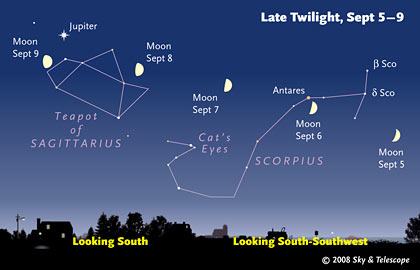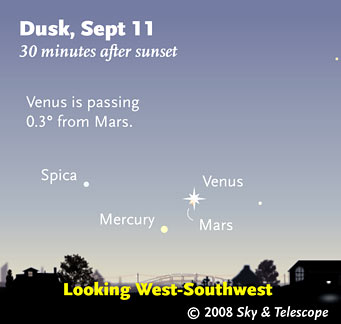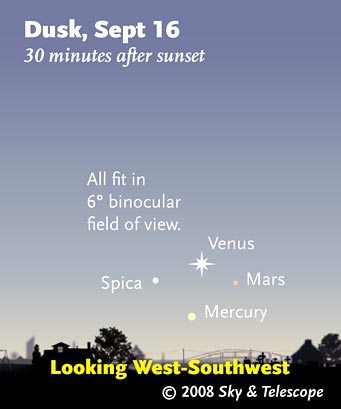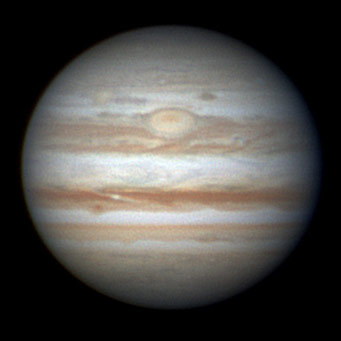Some daily events in the changing sky for September 5 – September 13.
Friday, September 5
The Red Spot transits about every 10 hours 56 minutes. For all its transit times, good worldwide, see our listing or applet online.

Watch the bright waxing Moon cross Scorpius and Sagittarius after dark in early September. (These scenes are drawn for the middle of North America. European observers: move each Moon symbol a quarter of the way toward the one for the previous date. For clarity, the Moon is shown three times actual size.)
Alan MacRobert
Saturday, Sept. 6
Sunday, September 7
Monday, September 8
Tuesday, September 9
Wednesday, September 10

Venus and faint Mars are in conjunction, with Mercury looking on from below.
Sky & Telescope diagram
Thursday, September 11
Friday, September 12
Saturday, September 13

With binoculars, watch Spica join in with Venus, Mercury, and Mars as the planets go through their evolving positions.
Sky & Telescope diagram
Want to become a better amateur astronomer? Learn your way around the constellations. They're the key to locating everything fainter and deeper to hunt with binoculars or a telescope. For an easy-to-use constellation guide covering the whole evening sky, use the big monthly foldout map in each issue of Sky & Telescope, the essential magazine of astronomy. Or download our free Getting Started in Astronomy booklet (which only has bimonthly maps).
Once you get a telescope, to put it to good use you'll need a detailed, large-scale sky atlas (set of maps; the standards are Sky Atlas 2000.0 or the smaller Pocket Sky Atlas) and good deep-sky guidebooks (such as Sky Atlas 2000.0 Companion by Strong and Sinnott, the even more detailed Night Sky Observer's Guide by Kepple and Sanner, or the classic Burnham's Celestial Handbook). Read how to use them effectively.
Can a computerized telescope take their place? As Terence Dickinson and Alan Dyer say in their Backyard Astronomer's Guide, "A full appreciation of the universe cannot come without developing the skills to find things in the sky and understanding how the sky works. This knowledge comes only by spending time under the stars with star maps in hand and a curious mind."
Without these, they wisely say, "the sky never becomes a friendly place."
More beginners' tips: "How to Start Right in Astronomy".
This Week's Planet Roundup
Mercury (about magnitude 0) is 3° or 4° lower left of much-brighter Venus, low in the west-southwest in bright twilight, as shown at the top of this page. Bring binoculars.
Venus (magnitude –3.8) is still low in the glow of sunset. Look for it above the western horizon about 30 minutes after sundown. Fainter Mercury is just to its lower left, as shown at the top of this page. Look too for even fainter Mars.
Mars (a dim magnitude +1.7!) is closing in on Venus from the upper left. It passes 1/3° south (lower left) of Venus on September 11th, then moves farther down to the lower right. See the illustration at the top of this page — and use binoculars! Spica, magnitude +1.0, is also nearby.

The Great Red Spot was on Jupiter's central meridian when Christopher Go took this image at 13:19 UT August 27, 2008. The central-meridian longitude (System II) was 128°. Note the reddish Oval BA to the Red Spot's upper left, and the bright white point marking the start of a new rift in the dark North Equatorial Belt (below center). A more extensive white disturbance has developed in the North Equatorial Belt on the other side of the planet. South is up, to match the south-up view in many telescopes.
Jupiter (magnitude –2.5, in Sagittarius) shines bright and steady in the south right after dark, and lower in the southwest later. It's above the Sagittarius Teapot and just below the smaller, dimmer Teaspoon.
Saturn is hidden behind the glare of the Sun.
Uranus and Neptune (magnitudes 5.7 and 7.8, respectively, in Aquarius and Capricornus) are well up in the southeast during evening. Use our online article and finder charts, or see the September Sky & Telescope, page 63.
Pluto (magnitude 14.0, in the northwestern corner of Sagittarius) is in the south-southwest right after dark. If you've got a big scope and a dark sky, use our article and finder chart.
All descriptions that relate to your horizon or zenith — including the words up, down, right, and left — are written for the world's mid-northern latitudes. Descriptions that also depend on longitude (mainly Moon positions) are for North America. Eastern Daylight Time (EDT) equals Universal Time (known as UT, UTC, or GMT) minus 4 hours.
To be sure to get the current Sky at a Glance, bookmark this URL:
http://SkyandTelescope.com/observing/ataglance?1=1
If pictures fail to load, refresh the page. If they still fail to load, change the 1 at the end of this URL to any other character and try again.
 0
0
Comments
You must be logged in to post a comment.